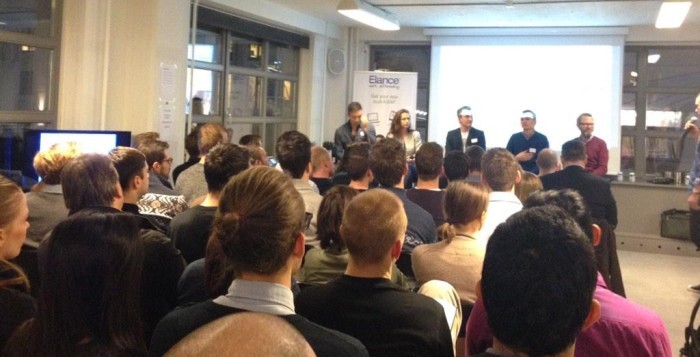Why founders make bullshit competitor slides and how to do it right

Pitch doctors will help you to make cool competitor slides. This post will not. Instead it will do the opposite. It will deconstruct competition into what really matters. In the process I will offend you. I will use examples involving your wife. I will use women as examples. Some will find it objectifying and sexists. My intention is to give your understanding. Understanding is power. Use it.
Most founders claim that competitors are inferior. Competitor’s products are hard to use, outdated and lacks features. Founders can prove it. They have a formula that objectifies competition into a clear and visual picture of exactly how superior their product is. The formula is called a 2 by 2 matrix and the picture is called the competitor slide.
 (The slide is borrowed from Steve Blank. Hope he don’t mind)
(The slide is borrowed from Steve Blank. Hope he don’t mind)
Every startup has the competitor slide. And they should. Investors want to see it. Mentors want you to create it. It is a powerful slide. Maybe the most powerful in the deck. It eliminates any question. Any doubt. The facts are clear. We are good and they are bad. It’s quantified and obvious.
Except that it is not obvious.
I used to nod when founders pitched the slide to us at Accelerace Invest. However, something about these slides didn’t seem right. After 3 years of startup investing, I know why. Lately, I have decided to tell founders the truth about competition slides.
Competition slides are fundamentally flawed
What if I told you this: My wife is better than your wife. And that you would be better off if you had a wife like mine! (If you have a husband, replace wife with husband in the rest of the post. Same with girlfriend or boyfriend)
Do you feel it? The sting. You probably like me a little less now. Maybe a lot less. The reason is obvious. I am incredibly rude. You probably think it is a ridiculous comparison. First of all, what do I really know about you wife? Secondly, what attributes do I compare? Thirdly, can spouse-quality even be objectified? What if our value set is different and you appreciate attributes, I do not care about.
By now you know where I am going. I will use the logic from the wife example to build my case.
Most founders are in love
Most founders have an emotional relationship with their startup. It is important that they do. If founders were not emotional, they would either be psychopaths or not believe in their startup. Belief is an emotional state. Steve Jobs was emotional. Some say it helped him succeed.
The emotion that founders feel is something close to being in love. I felt it every time. Psychologists would call it positivity bias. Economists would call it escalating commitment. A phenomenon where people can no longer make rational judgments, and will continue down a path even though it is no longer the optimal thing to do. They have invested a lot in their current path and don’t face reality.
The emotional relationship affects founders. Here, we have the first point of similarity to the wife comparison. We feel love for our spouse. We feel love for our startup. In both cases we have positivity bias. We cannot make rational judgments.
Conclusion: Founders are in love and it clutters their judgment
Most founders don’t really know their competitors
When I claimed my wife was better than your wife, you most likely thought: I don’t really know your wife. You are right. I don’t. I only know what I can observe in public. I don’t know what she is like at home. Most people act differently in public. They show their best side. I know nothing.
When founders evaluate competition they use public information. They visit their competitors’ websites. Sometimes they test their products. Maybe founders pick up rumors. They are evaluating someone else’ spouse. Unless the founders use to be a core team member at the competing company, they know nothing.
The founders don’t know the competitors’ product pipeline, their sales pitch, the strength of relationships to their customers, the marketing strategy or the culture. Companies don’t just compete on descriptions of features on their website.
Conclusion: Founders rarely know enough about competitors to truly evaluate them
The variables founders compare are random
You wondered which variables I used to conclude that my wife is better than yours. Did I use looks, intelligence, career success, value system or something else?
I used whatever supported my conclusion. I am in love. I think my wife is the best. I will justify it. And I will pick the variables that support this picture. The game is rigged.
Founders do the same. The love for their startup convinces founders that it is the best. The conclusion is established. Now they just need to choose the variables that support what they already believe. The variables serve the purpose. They become random. In the end they ensure a place in the right hand corner of the 2 by 2 matrix. The spot of superiority.

Conclusion: Most 2 by 2 matrices are reversed engineered with variables fitting the conclusion
The startup serves other people. Not themselves.
I claimed that you would be better off having my wife. Or at least one exactly like her. That claim would require I knew you intimately. I would have to be your best friend or your brother. Anything further from that and the suggestion would seem preposterous. Few new friendship would survive such a suggestion.
The reason is simple. You are the one who must live with her. And I do not know you well enough.
The same is true for the product or services of the startup. It is the customers who will live with the product or service. Not the founders. Then wouldn’t it be important to know what the customers value? Do the founders know the customers well enough. Like a best friend or a brother?
In most cases founders do not know the customers to that degree. Do you see the problem?
What would a professional matchmaker do? She would interview her customer and ask him about his preferences. What attributes are important to him. Have him rank them. Only then would she score potential candidates to find his match.
Conclusion: Only customers can truly provide accurate variables
The score assigned to the attributes are assessed by the wrong people
Let’s say I interviewed you. The attributes you chose on the Y and X axis were the ones you proposed. Let’s say those attributes were physical attractiveness and parenting skills.
Let us even say that you knew my wife intimately.
I showed you my matrix. It looks right. Physical attractiveness and parenting skills make up the axes. However, my wife is in the upper right hand corner. Your wife is in the low left corner. Maybe you don’t agree.
The problem is the score. You might find blond hair sexy. I find black hair sexy. You might think children should have strict rules. I might think children should do as they please. Different people value different things differently. Who is right? You are. The customer.
I cannot count the number of times founders told me that their software is easier to use their competitor’s software. Well, my mother just returned her iPhone because she found it too difficult to use. My daughter cannot use anything but an iPhone.
The thing is that the score depends on the customer segment. If segmented right, customers will be homogeneous. They will be similar in the way they prioritize, make decisions and value things. In other words, the score is segment dependent. So when founders create their competition slide, they must understand which customer segment it represents.
Conclusion: The scores of the variables depends on the segment
The perfect depiction of competition does not exist
Okay. I have made my case. I have rendered the competition slide useless. I think I even used the word bullshit. I rarely curse.
Then what should founders do? Well if they want to convince other people that they are on a winning path, founders should stick with the classic 2 by 2 matrix. It just works.
If founders truly want to understand competition they must reverse the process. Instead of establishing the conclusion and then justify it, they must seek the truth. It might not pretty.
The truth is hidden in the mind of the customer. The human beings in the customer segment that the startup is focusing on. The users and the buyers.
Founders must talk to customers and identify what they find important. They must ask them to rank those attributes. And founders must ask customers to help score the different competing solutions on these attributes.
The picture will be muddy. The process will be painful. The result cannot be used in pitch contests. But it can be used to understand how customers really evaluate their available solutions. The true picture will help founders to make sure their product or service becomes truly superior.
Conclusion: Founders must include customers in their competitor analysis and snap out of love for a while
Conclusions:
- Founders are in love and it clutters their judgment
- Founders rarely know enough about competitors to truly evaluate them
- Most 2 by 2 matrices are reversed engineered with variables fitting the conclusion
- The scores on the variables depends on the segment
- Founders must include customers in their competitor analysis and snap out of love for a while
David Ventzel is an investor at Accelerace. This article was originally posted on his blog.







